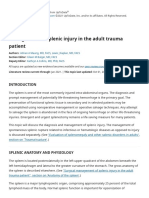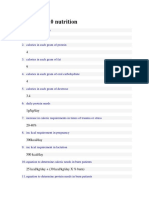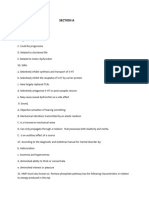0 ratings0% found this document useful (0 votes)
57 viewsUrology: Schwartz's Principles of Surgery 11th Ed
Urology: Schwartz's Principles of Surgery 11th Ed
Uploaded by
addelins1. The kidneys are paired retroperitoneal organs located posterior to the peritoneum and invested in Gerota's fascia. Each kidney receives its blood supply from a renal artery branching directly from the abdominal aorta.
2. Common causes of urinary tract obstruction include urolithiasis, benign prostatic hyperplasia, and urethral strictures. Kidney stones are usually treated with shockwave lithotripsy, ureteroscopy, or percutaneous nephrolithotomy depending on stone size and location. Benign prostatic hyperplasia is usually treated initially with pharmacotherapy but may require transurethral resection of the prostate for larger obstructions.
3.
Copyright:
© All Rights Reserved
Available Formats
Download as PPTX, PDF, TXT or read online from Scribd
Urology: Schwartz's Principles of Surgery 11th Ed
Urology: Schwartz's Principles of Surgery 11th Ed
Uploaded by
addelins0 ratings0% found this document useful (0 votes)
57 views34 pages1. The kidneys are paired retroperitoneal organs located posterior to the peritoneum and invested in Gerota's fascia. Each kidney receives its blood supply from a renal artery branching directly from the abdominal aorta.
2. Common causes of urinary tract obstruction include urolithiasis, benign prostatic hyperplasia, and urethral strictures. Kidney stones are usually treated with shockwave lithotripsy, ureteroscopy, or percutaneous nephrolithotomy depending on stone size and location. Benign prostatic hyperplasia is usually treated initially with pharmacotherapy but may require transurethral resection of the prostate for larger obstructions.
3.
Original Title
UROLOGY
Copyright
© © All Rights Reserved
Available Formats
PPTX, PDF, TXT or read online from Scribd
Share this document
Did you find this document useful?
Is this content inappropriate?
1. The kidneys are paired retroperitoneal organs located posterior to the peritoneum and invested in Gerota's fascia. Each kidney receives its blood supply from a renal artery branching directly from the abdominal aorta.
2. Common causes of urinary tract obstruction include urolithiasis, benign prostatic hyperplasia, and urethral strictures. Kidney stones are usually treated with shockwave lithotripsy, ureteroscopy, or percutaneous nephrolithotomy depending on stone size and location. Benign prostatic hyperplasia is usually treated initially with pharmacotherapy but may require transurethral resection of the prostate for larger obstructions.
3.
Copyright:
© All Rights Reserved
Available Formats
Download as PPTX, PDF, TXT or read online from Scribd
Download as pptx, pdf, or txt
0 ratings0% found this document useful (0 votes)
57 views34 pagesUrology: Schwartz's Principles of Surgery 11th Ed
Urology: Schwartz's Principles of Surgery 11th Ed
Uploaded by
addelins1. The kidneys are paired retroperitoneal organs located posterior to the peritoneum and invested in Gerota's fascia. Each kidney receives its blood supply from a renal artery branching directly from the abdominal aorta.
2. Common causes of urinary tract obstruction include urolithiasis, benign prostatic hyperplasia, and urethral strictures. Kidney stones are usually treated with shockwave lithotripsy, ureteroscopy, or percutaneous nephrolithotomy depending on stone size and location. Benign prostatic hyperplasia is usually treated initially with pharmacotherapy but may require transurethral resection of the prostate for larger obstructions.
3.
Copyright:
© All Rights Reserved
Available Formats
Download as PPTX, PDF, TXT or read online from Scribd
Download as pptx, pdf, or txt
You are on page 1of 34
UROLOGY
Schwartz’s Principles of Surgery 11th Ed.
dr. WIKO WICAKSONO
IIlmu Bedah dan Ilmu Orthopedi dan Traumatologi Juli 2021
Anatomy
Kidney and Adrenal Gland
• The kidneys are paired retroperitoneal
organs that are invested in a fibro-fatty
layer of tissue known as Gerota’s fascia
• Borders:
Right Kidney anterolaterally by the liver
and the ascending colon
Left Kidney anterolaterally by the spleen
and descending colon
Posterolaterally by the quadratus lumborum
muscle
Posteromedially by the psoas muscle
• The renal arteries extend from the aorta and then
branch into several segmental arteries and
arterioles before becoming glomeruli
• Each artery runs posterior to their respective renal
vein
• Each renal vein drains directly into the IVC
• The collecting system begins as minor calyces near
the renal papillae and then coalesces into major
calyces->down to the ureteropelvic junction (UPJ),-
>renal Pelvis-> Ureter
• The adrenal gland is superomedial to its respective
kidney within Gerota’s fascia
Ureter
The ureters are smooth muscle–based tubular structures that connect
the renal pelvis to the bladder
The proximal blood supply inserts on the medial aspect of the ureter
and arises from the aorta and renal artery, and the distal blood supply
inserts laterally and arises from the surrounding iliac vessels and their
branches
The ureters initially course along the psoas muscle and then run
distally along the pelvic sidewall
The ureters enter the bladder laterally and pass through the bladder
wall at an oblique angle
The ureters propel urine into the bladder via the ureteral orifices
Bladder and Prostate
The bladder is located extraperitoneally in the pelvis and posterior
to the pubis
The average adult bladder holds approximately 500 mL of urine;
however, in rare cases, capacity can reach up to or greater than 1000
mL
The prostate is a walnut-shaped gland that encircles the urethra and
is located in males immediately beneath the bladder neck
Smooth muscle fibers distribute throughout the gland, which can
contract and facilitate bladder outlet obstruction
The average prostate measures approximately 30 mL in volume
Vasculature to the bladder and prostate arises from the superior and
inferior vesical arteries, which branch from the internal iliac arteries
Penis
The penis is comprised of three bodies: two corpora
cavernosa, which are responsible for erection, and
the corpus spongiosum, which surrounds the urethra
and gives rise to the glans penis
These three structures are all encased by skin and
dartos fascia, as well as an inner investing layer of
fascia called Buck’s fascia
The corpora cavernosa are spongy sinusoidal bodies
that expand with parasympathetic neural stimulation
to create an erection
The corpus spongiosum is located on the ventrum of
the penis
Scrotum and Testes
The scrotum is comprised of many layers aside from skin and dartos
fascia, and each derives from a particular layer of the anterior
abdominal wall
The testes are separated from the scrotal layers by the visceral and
parietal layers of the tunica vaginalis, between which hydroceles
form
The spermatic cord contains the vas deferens, the venous
pampiniform plexus, and arterial blood supply to the superior pole
of the testis via three separate sources
The testicular artery arises directly from the aorta; the deferential
artery, which supplies the vas deferens, arises from the internal iliac
artery; and the cremasteric artery, which supplies the cremaster
musculature, arises from the external iliac artery
2. Infection
Uncomplicated Cystitis
Uncomplicated cystitis usually presents as new onset urinary, frequency, urgency, dysuria, lower
back pain, suprapubic pain, foul-smelling urine, or gross hematuria
Urinalysis with microscopy assists with diagnosis by confirming the presence of pyuria,
hematuria, and bacteriuria
Three days of antibiotics are generally sufficient for treatment of uncomplicated cystitis
Complicated Cystitis
Complicated cystitis may arise in the setting of structural or functional urinary tract
abnormalities, recent urinary tract instrumentation, recent antimicrobial use,
immunosuppressed states, pregnancy, or hospital-acquired infection
Symptoms may be similar to uncomplicated cystitis but can progress to pyelonephritis if left
untreated
Treatment consists of 10 to 14 days of antibiotics
Pyelonephritis Pyelonephritis arises when a bladder infection ascends proximally along the
ureters to the renal parenchyma, hematogenous spread, such as in the case of
intravenous drug abuse or in patients with bacteremia from other sources
present with fevers, flank pain, nausea, vomiting, and lower urinary tract
symptoms, tenderness of the costovertebral angle
Acute pyelonephritis requires 7 to 14 days of antibiotic therapy
Prostatitis
• Acute prostatitis is marked by fever, suprapubic or perineal pain, and new onset
lower urinary tract symptoms, namely dysuria, frequency, urgency, changes in stream
caliber, or difficulty emptying the bladder
• Digital rectal exam may reveal a tender and soft prostate
• Treatment consists of a long-term course (4–6 weeks) of antibiotics
• If not treated in a timely fashion, acute prostatitis can develop into severe sepsis or a
prostatic abscess
• Prostatic abscesses may require drainage via a transurethral approach or transrectal
needle aspiration
Epipidymo-Orchitis
Common etiologies include sexually transmitted infection, urinary tract infection, underlying
congenital urologic abnormality or incomplete bladder emptying
Symptoms include pain and swelling of the epididymis and testis
Physical exam generally reveals a tender, swollen epididymis and testis
Treatment of epididymo-orchitis consists of single dose of ceftriaxone and azithromycin if there
is concern for sexually transmitted infection, as well as 14 days of oral antibiotic therapy,
NSAIDs, and scrotal support
Balanitis and Balanophostitis
Balanitis refers to inflammation of the glans penis. Balanoposthitis arises when the foreskin is
also involved
Common etiologies include fungal infection, bacterial infection, contact dermatitis, or local
trauma
Exam reveals a diffusely erythematous and warm glans penis, with inner preputial erythema as
well if balanoposthitis is present
Treatment includes appropriate hygiene, topical antibiotics or antifungals, and occasionally
topical steroids
3. Urinary Tract Obstruction
Urolithiasis
• Stones are most commonly composed of calcium oxalate, calcium phosphate, uric acid, cystine,
medication-related, and infectious stones (struvite or carbonate apatite) or a mix thereof
• Evaluation for first-time stone formers should include a complete medical history and physical
exam, basic metabolic panel, calcium, uric acid, urinalysis and culture, and radiographic imaging
• Smaller and more distal stones are much more likely to pass spontaneously without the need for
surgical intervention(Ablocker)
• Patients who have not passed their stone after a 4- to 6-week observation period, those with
larger stones, or those who desire immediate intervention, may be offered one of three
definitive surgical interventions: shockwave lithotripsy (SWL), ureteroscopy (URS), or
percutaneous nephrolithotomy (PCNL)
• General preventative measures include correcting dietary habits, particularly increasing fluid
intake to produce >2.5 liters of urine per day, limiting sodium, reducing animal protein intake,
and monitoring foods high in oxalate
Benign Prostatic Hyperplasia
• Histological findings of smooth muscle and fibroblast/epithelial cell
proliferation
• in the transition zone of the prostate
• Lower urinary tract symptoms (LUTS) may be secondary to benign prostatic
enlargement (BPE) causing progressive bladder outlet obstruction
• The first line of treatment is most commonly pharmacotherapy
• Transurethral resection of the prostate (TURP) remains the mainstay of
endoscopic procedures, with low treatment failure and complication rates
A urethral stricture is an area of scarring or fibrosis that causes
Urethral concentric narrowing of the urethra, impeding the flow of urine
Stricture as it drains from the bladder
A stricture can occur in any segment of the urethra, but it is most
common in the bulbar urethra
Options to treat urethral stricture disease can be divided into two
general categories: endoscopic (direct vision internal
urethrotomy) and surgical reconstruction (urethroplasty)
Other
•Retroperitoneal fibrosis (RPF) is a rare cause of ureteric obstruction secondary to an inflammatory and
fibrotic process of the retroperitoneal structures-> Idiopatic(70%). Identifiable causes periaortic
inflammation due to aneurysms, medications
•Symptoms are nonspecific and may include general abdominal discomfort or back pain, flank pain due
to ureteral obstruction, or lower extremity edema due to vena caval compression.
•Laboratory abnormalities such as normocytic anemia, an elevated C-reactive protein,
•Patients with symptomatic renal obstruction, renal insufficiency, or signs of infection should be
decompressed with either ureteral stents or nephrostomy and monitored for postobstructive diuresis.
Biopsy of the retroperitoneal mass to exclude malignancy should be considered prior to commencing
treatment. Steroid therapy remains the mainstay of medical treatment, although other
immunosuppressive agents have been described.
• If medical treatment fails, open or minimally invasive bilateral ureterolysis with intraperitonealization
or omental wrapping of the ureters is indicated.
4. Genitourinary Trauma
Kidney
The prime goal of renal trauma management is preservation of renal function. Renal
trauma has become largely nonoperative in modern times, especially in the setting of
low- to intermediate grade renal injuries from a blunt mechanism of action.
The first goal of renal trauma is to accurately grade the renal injury. The gold standard
test to diagnose and stage a renal injury includes a CT scan with IV contrast.
Criteria that would mandate renal imaging include the presence of gross hematuria,
microscopic hematuria with hypotension, and mechanisms increasing the prevalence of
renal injury (sudden deceleration injuries, flank contusion.
The American Association for the Surgery of Trauma (AAST) renal
trauma grading system
The management of renal injuries depends not only on the grade but also on the injury
mechanism and clinical symptoms.
Absolute indications for surgical or radiological intervention on renal trauma life-threatening
hemorrhage, renal pedicle avulsion, or pulsatile/expanding retroperitoneal hematoma. suffering
penetrating renal trauma with a retroperitoneal hematoma should undergo exploration when
hemodynamic instability.
Hemodynamically stable patient with a renal Injury renal trauma should be initially observed.
Conservative management : entails bed rest and hemodynamic monitoring. Patients with a
grade 4 renal injury should be treated in the same manner, and a repeat CT scan should be done
to make certain that the urinary extravasation has resolved.
Ureters
•There is no association between the magnitude of ureteral injuryand the degree of hematuria
that is present. Unlike renal injury, the ureters more commonly are injured through iatrogenic
mechanisms
•Diagnosis requires either a CT urogram, IVP, or a cystoscopy with a retrograde pyelogram.
•The repair of ureteric injuries depends on the time of identification from initial injury, location,
and length of the injured ureteral segment involved
•Iatrogenic ureteral injuries should be initially managed with ureteral stent placement when
possible, if not possible -> open repair
•Ureteral injuries of traumatic origin (penetrating injuries, multiple intra-abdominal traumas)
should be repaired when possible. if not possible -> the ureter can be ligated with subsequent
nephrostomytube
Blader
The bladder can be injured through iatrogenic and classic traumatic mechanisms.
Indications for bladder imaging include gross hematuria in the setting of injuries with a
correlation for bladder injury.
Diagnosis of bladder injuries requires either a CT cystogram or a fluoroscopic cystogram.
5. Emergencies
6. Urologic Malignancies
7. Common Urologic Conditions
8. Pediatric Urology
You might also like
- Schwartz UrologyDocument10 pagesSchwartz UrologyRem Alfelor100% (1)
- Gastric Outlet Obstruction, A Simple Guide To The Condition, Diagnosis, Treatment And Related ConditionsFrom EverandGastric Outlet Obstruction, A Simple Guide To The Condition, Diagnosis, Treatment And Related ConditionsNo ratings yet
- Medcosmos Surgery: Spleen MCQDocument19 pagesMedcosmos Surgery: Spleen MCQSajag GuptaNo ratings yet
- Surgery Notes PDFDocument7 pagesSurgery Notes PDFhassan_5953No ratings yet
- Gallbladder and Pancrease PathologyDocument4 pagesGallbladder and Pancrease Pathologyjohn smithNo ratings yet
- ILA - Hirschsprungs DiseaseDocument48 pagesILA - Hirschsprungs DiseaseSoleh Ramly100% (1)
- The Liver: Dr. I Made Naris Pujawan, M.Biomed, SP - PADocument19 pagesThe Liver: Dr. I Made Naris Pujawan, M.Biomed, SP - PAAnonymous D29e00No ratings yet
- Managment of Acute Pancreatitis ACGG 2024Document19 pagesManagment of Acute Pancreatitis ACGG 2024Juan Francisco Piedra RubioNo ratings yet
- Case Presentation:: DR - Amra Farrukh PG.T Su.IDocument75 pagesCase Presentation:: DR - Amra Farrukh PG.T Su.IpeeconNo ratings yet
- Surgery I Block 4 Super Reviewer PDFDocument14 pagesSurgery I Block 4 Super Reviewer PDFlems9No ratings yet
- Intra Abdominal 2009Document8 pagesIntra Abdominal 2009Shinta Dwi Septiani Putri WibowoNo ratings yet
- Urinary DiversionDocument11 pagesUrinary Diversionvlad910No ratings yet
- Surgery 2 SEPT SOLVEDDocument28 pagesSurgery 2 SEPT SOLVEDSam0% (1)
- SURGERY Lecture 5 - Abdominal Wall, Omentum, Mesentery, Retroperitoneum (Dr. Wenceslao)Document13 pagesSURGERY Lecture 5 - Abdominal Wall, Omentum, Mesentery, Retroperitoneum (Dr. Wenceslao)Medisina101No ratings yet
- 21 Obstructive JaundiceDocument12 pages21 Obstructive JaundicejumaymayaNo ratings yet
- Management of Splenic Injury in The Adult Trauma PatientDocument33 pagesManagement of Splenic Injury in The Adult Trauma PatientHohai ConcepcionNo ratings yet
- Systemic Response To InjuryDocument58 pagesSystemic Response To InjuryJustinNo ratings yet
- Surgery 1.1 Fluid and Electrolyte Balance - Azares PDFDocument7 pagesSurgery 1.1 Fluid and Electrolyte Balance - Azares PDFAceking MarquezNo ratings yet
- Pathophysiology: Rectal CarcinomaDocument25 pagesPathophysiology: Rectal CarcinomaCristina CristinaNo ratings yet
- In The Clinic - Acute PancreatitisDocument16 pagesIn The Clinic - Acute PancreatitisSurapon Nochaiwong100% (1)
- Kholesistis & Kholelitiasis 30-11-14Document67 pagesKholesistis & Kholelitiasis 30-11-14Dian AzhariaNo ratings yet
- Surgical Anatomy of The Chest Wall, Pleura, and MediastinumDocument8 pagesSurgical Anatomy of The Chest Wall, Pleura, and MediastinumNooneNo ratings yet
- Surgery 1.02 Systemic Responses To Injury and Metabolic Support - Dr. AgustinDocument15 pagesSurgery 1.02 Systemic Responses To Injury and Metabolic Support - Dr. AgustinJorge De VeraNo ratings yet
- Portal HypertensionDocument32 pagesPortal HypertensionCs KarthikNo ratings yet
- 4.2 Abdominal Wall Hernia (Jerome Villacorta's Conflicted Copy 2014-03-22)Document7 pages4.2 Abdominal Wall Hernia (Jerome Villacorta's Conflicted Copy 2014-03-22)Miguel C. DolotNo ratings yet
- Surgicl Pathology of OesophagusDocument91 pagesSurgicl Pathology of Oesophagusmikaaa000No ratings yet
- Approach To Patients With Abdominal Pain-ValenDocument49 pagesApproach To Patients With Abdominal Pain-ValenCitra Sucipta0% (1)
- Renal PathDocument71 pagesRenal PathSuha AbdullahNo ratings yet
- Ssat Absite Review: HPB: Douglas Cassidy, MD MGH Surgical Education Research and Simulation FellowDocument19 pagesSsat Absite Review: HPB: Douglas Cassidy, MD MGH Surgical Education Research and Simulation FellowmikhailNo ratings yet
- Incisional Hernia RepairDocument6 pagesIncisional Hernia RepairLouis FortunatoNo ratings yet
- Marjolin Ulcer POSTER (RSCM)Document1 pageMarjolin Ulcer POSTER (RSCM)Juli Jamnasi100% (1)
- Mass in Epigastrium-2Document37 pagesMass in Epigastrium-2brown_chocolate87643100% (1)
- Malrotation of Gut: Pravin NarkhedeDocument44 pagesMalrotation of Gut: Pravin Narkhedepravin narkhede0% (1)
- Esophageal CADocument17 pagesEsophageal CASesrine BuendiaNo ratings yet
- Robotic SurgeryDocument10 pagesRobotic Surgerys_asmathNo ratings yet
- Surgery ExamDocument82 pagesSurgery Examrajarajachozhan139No ratings yet
- Systemic Response To InjuryDocument5 pagesSystemic Response To InjuryJohn Christopher LucesNo ratings yet
- Benign Anorectal Conditions: Ahmed Badrek-AmoudiDocument20 pagesBenign Anorectal Conditions: Ahmed Badrek-AmoudiAna De La RosaNo ratings yet
- Systemic Response To Injury and Metabolic SupportDocument84 pagesSystemic Response To Injury and Metabolic SupportWaldi KurniawanNo ratings yet
- Robbins Ch. 19 The Pancreas Review QuestionsDocument3 pagesRobbins Ch. 19 The Pancreas Review QuestionsPA2014100% (1)
- Anomalies of Rotation To CDDocument15 pagesAnomalies of Rotation To CDGren May Angeli Magsakay100% (1)
- (DERMA) 03 TineasDocument9 pages(DERMA) 03 TineasJolaine ValloNo ratings yet
- Colorectal Ca (CRC) .: Malueth Abraham, MBCHB ViDocument36 pagesColorectal Ca (CRC) .: Malueth Abraham, MBCHB ViMalueth AnguiNo ratings yet
- Acid Base SchwartzDocument13 pagesAcid Base SchwartzRJ TanNo ratings yet
- Hydatid Cyst Case ReportDocument10 pagesHydatid Cyst Case ReportAbdullah ZakiNo ratings yet
- Shock (For Surgery)Document50 pagesShock (For Surgery)Emmanuel Rojith VazNo ratings yet
- Surgery PDFDocument4 pagesSurgery PDFJanine Maita BalicaoNo ratings yet
- Pancreatic Cancer: Aziz Ahmad, MD Surgical Oncology Mills-Peninsula Hospital April 23, 2011Document18 pagesPancreatic Cancer: Aziz Ahmad, MD Surgical Oncology Mills-Peninsula Hospital April 23, 2011mywifenoor1983No ratings yet
- Pathology of Digestive SystemDocument28 pagesPathology of Digestive SystemDianNursyifaRahmahNo ratings yet
- ABSITE CH 10 Nutrition PDFDocument8 pagesABSITE CH 10 Nutrition PDFJames JosephNo ratings yet
- Colorectal CancerDocument39 pagesColorectal CancerFernando AnibanNo ratings yet
- Basic Emergency Skills in Trauma Part 3 - Penetrating Abdoninal Injury - Dr. Oliver BelarmaDocument3 pagesBasic Emergency Skills in Trauma Part 3 - Penetrating Abdoninal Injury - Dr. Oliver BelarmaRaquel ReyesNo ratings yet
- Absite CH 32 BilliaryDocument14 pagesAbsite CH 32 BilliaryJames JosephNo ratings yet
- PeritonitissDocument46 pagesPeritonitissNinaNo ratings yet
- Complications of PCNL: DR - Sanjay S Deshpande Sidheshwar Urological Society SolapurDocument20 pagesComplications of PCNL: DR - Sanjay S Deshpande Sidheshwar Urological Society SolapurAlat MasakNo ratings yet
- Surgery 6th TCVSDocument3 pagesSurgery 6th TCVSRem AlfelorNo ratings yet
- 4 Lecture Notes Urology 6th Edition by Amir Kaisary and John BlandyDocument11 pages4 Lecture Notes Urology 6th Edition by Amir Kaisary and John Blandyapi-237463278No ratings yet
- Lecture StomachDocument31 pagesLecture StomachAmaetenNo ratings yet
- Peri Ampullary TumorDocument69 pagesPeri Ampullary TumorMuhammed Muzzammil SanganiNo ratings yet
- 1704 New Ectoin Anti-Pollution SummaryDocument27 pages1704 New Ectoin Anti-Pollution SummaryIlham Abinya LatifNo ratings yet
- PersonalityDocument10 pagesPersonalityantiNo ratings yet
- Antiemetic Drug Use in Children What The.3Document6 pagesAntiemetic Drug Use in Children What The.3Zafitri AsrulNo ratings yet
- Umbi GembiliDocument8 pagesUmbi GembiliZakaria SandyNo ratings yet
- Arthur Steindler: Pes Cavus (1921), He Analyzed The Muscle ImbalDocument3 pagesArthur Steindler: Pes Cavus (1921), He Analyzed The Muscle Imbalisaac b-127No ratings yet
- LipidsDocument40 pagesLipidsKlimpoy WatashiewaNo ratings yet
- 3august - Grade 9 - 1st Quarter TestDocument22 pages3august - Grade 9 - 1st Quarter TestLucille Gacutan Aramburo0% (1)
- Unit 7. Sympathomimetics and SympatholyticsDocument44 pagesUnit 7. Sympathomimetics and SympatholyticsApril Mergelle Lapuz100% (2)
- Jaundice Case PrresentationDocument30 pagesJaundice Case PrresentationUday KumarNo ratings yet
- Introducing The Blind Man Technique-Study Less and Retain MoreDocument9 pagesIntroducing The Blind Man Technique-Study Less and Retain Moreskycall28No ratings yet
- Classification of Sleep DisordersDocument15 pagesClassification of Sleep Disorderselvinegunawan100% (1)
- Neonatal JaundiceDocument32 pagesNeonatal JaundiceKiran KumarNo ratings yet
- Metabolism: Written by TutorDocument4 pagesMetabolism: Written by TutorRyan Carlo CondeNo ratings yet
- Chapter 43Document20 pagesChapter 43Malou Yap BuotNo ratings yet
- Block 2.1 PBL 2024Document13 pagesBlock 2.1 PBL 2024ENOCH NAPARI ABRAMANNo ratings yet
- Aurone & ChalconeDocument26 pagesAurone & ChalconeAulia Suci WulandariNo ratings yet
- 13 OCTOBER, 2021 Wednesday Biology Transport SystemDocument12 pages13 OCTOBER, 2021 Wednesday Biology Transport SystemOyasor Ikhapo AnthonyNo ratings yet
- Dr. Carlos S. Lanting College: Outcomes-Based Education Course Syllabus MLS ON LINE CLASS - Student'sDocument7 pagesDr. Carlos S. Lanting College: Outcomes-Based Education Course Syllabus MLS ON LINE CLASS - Student'sGabriel CruzNo ratings yet
- NCP, PL, DPDocument6 pagesNCP, PL, DPJazel Algara JompillaNo ratings yet
- Bio Factsheet: Haemoglobin: Structure & FunctionDocument3 pagesBio Factsheet: Haemoglobin: Structure & FunctionNaresh Mohan0% (1)
- GHFHFDocument6 pagesGHFHFNAstyaNo ratings yet
- Anatomy of Fascial SpacesDocument40 pagesAnatomy of Fascial SpacesAKSHAYA SUBHASHINEE DNo ratings yet
- 【Zybio】Z3 hematology analyzer service training V3.0 - 2019.04.24Document126 pages【Zybio】Z3 hematology analyzer service training V3.0 - 2019.04.24tfmvbty2mzNo ratings yet
- Oleander, Paracetamol, Benzodiazepam Poisoning by DR - Ark.pandiyan YadavDocument18 pagesOleander, Paracetamol, Benzodiazepam Poisoning by DR - Ark.pandiyan YadavAnonymous AIHTVRfNo ratings yet
- Revision For Assessment II (Y8)Document33 pagesRevision For Assessment II (Y8)Nan Hay Zun Naung LattNo ratings yet
- Diagram Human Heart Kel 1Document3 pagesDiagram Human Heart Kel 1Rahma SafitriNo ratings yet
- Classification: HypertensionDocument13 pagesClassification: HypertensiontermskipopNo ratings yet
- Practice Bulletin: Antiphospholipid SyndromeDocument8 pagesPractice Bulletin: Antiphospholipid SyndromeSus ArNo ratings yet
- Certificate of HealthDocument1 pageCertificate of HealthRozaliamayasariNo ratings yet
- Pathophysiology of Brain TumorDocument15 pagesPathophysiology of Brain TumorJosue HerreraNo ratings yet

























































































